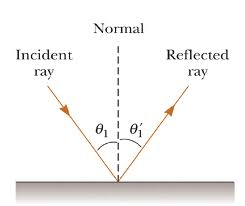
1) at right angles to the mirror located at the point where the rays meet. The law of reflection requires that two rays are at identical angles but on opposite sides of the normal which is an imaginary line (dashed in Fig. In Figure 1 we use a single line to illustrate a light ray reflected from the surface. Reflection involves two rays - an incoming or incident ray and an outgoing or reflected ray. A beam of light incident on the metal surface is reflected.

Polished metal surfaces reflect light much like the silver layer on the back side of glass mirrors. The walls in the room that you are in do not emit their own light they reflect the light from the ceiling "lights" overhead. What is it about objects that let us see them? Why do we see the road, or a pen, or a best friend? If an object does not emit its own light (which accounts for most objects in the world), it must reflect light in order to be seen. At this angle and all angles beyond this point, (including 45°) the incident light reflects totally within the prism.The Reflection of Light All Things Reflected This phenomenon is very useful in 45° prisms because the critical angle for BK7 and UVFS is approximately 41 degrees. In other words, there is no transmission to n, for any angle beyond the critical angle (unlike Brewster's Angle, which exists only at one point The critical angle is the point at which all of the incident light starts to totally reflect within the higher index medium. Whenever incident light travels from a high index medium to a low index medium (ie: glass to air), the critical angle is another useful tool for many optical applications including prisms. Special Case 2: Critical Angle (for Total Internal Reflection) To calculate the Brewster's Angle for a given material, use the following equation: Brewster's angle is often used in conjunction with polarizer coatings to minimize laser coupling loss and to maximize the signal strength of the desired light source. Brewster's angle has particular usefulness in optical applications where the P-Polarized signal (transmitting portion) must be optimized. For our simple air/glass interchange, Brewster's Angle is 56° 39′. Step 3: Once you have all four variables, use Fresnel's laws to calculate the loss in intensity due to reflection:Ī) Reflection loss for any angle of incidence:ī) Reflection loss for normal (0 degree) incidence:įor our air/glass interchange with normal incidence, reflection loss is about 4%.įor any given material, Brewster's Angle is the angle of incidence at which point the P-Polarization of the reflected portion, RP, is equal to 0. Step 2: Use Snell's law to define the relationship between n 1, n 2, θ 1 and θ 2 Θ 1 = angle of incidence (or incoming angle) = angle of reflection In the special case of a vacuum or air, n=1. However, it should be noted that the index of refraction for a given material is a function of wavelength and index increases as the wavelength gets shorter.

All optical materials have a unique index of refraction that is a key characteristic of the material (ie: ZnSe, n=2.4). To Determine the answers to these questions, follow the steps below: Step 1: Define the variablesįind the index of refraction for both lower and higher mediums. What is the effect of polarization on the reflected and refracted portions of the incident light? What is the reflection loss of the incident light?ģ. What is the angle of refraction (θ 2) relative to the incident (θ 1) light? (It is generally known that the angle of reflection is equal to the angle of incidence).Ģ. There are three important considerations whenever this happens:ġ. Whenever an incident light traveling through one medium (ie: air with an index of refraction, denoted by "n", of 1) comes into contact with another medium with a high index of refraction (ie: glass with n=1.52), there is a reflected portion (bounces off the surface), and a refracted portion (transmits through the surface). We will also discuss two special cases, Brewster's Angle and the Critical Angle, which hae valuable applications in optics. In this section, we will discuss some of the basic behaviors of light when it travels from one medium to another. Tech Notes » Reflection & Refraction of Light Tutorial


 0 kommentar(er)
0 kommentar(er)
